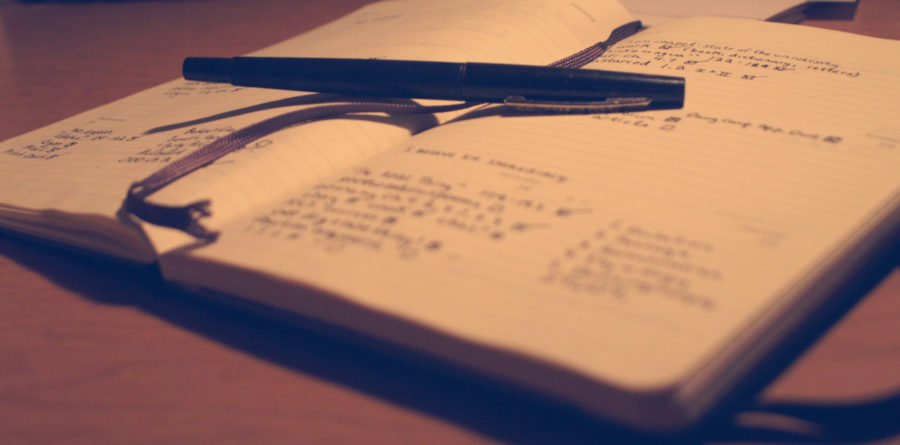Schafer: I’m hyperfocusing on… my planner journey
April 12, 2021
Editor’s Note: This column is a part of a series called “I’m hyperfocusing on…”.
As we’re coming in to the end of the semester, stress might be mounting a little high for students. I’ll be the first to admit to procrastinating more of my coursework than I should’ve earlier this semester, and I’m finding that I have a lot more to catch up on than I’d realized.
The advice I’m usually given in response to this is “Get a planner! It’ll help you stay on top of things!” I’m here to tell you I’ve tried just about every trick in the book to find something that works. In fact, I’m going to share some of those tricks for anybody who might be in need of some extra inspiration.
The first planner I remember using was something like this but with a little box in the corner of each space that my mother would initial to validate that she’d seen it. These were handed out by my teachers in second grade and were mandatory through the rest of elementary school.
There was a stretch of time that I used Google Calendar to keep track of my assignments in junior high while our coursework was posted through Google Classroom (similarly to Canvas here at Iowa State). I found myself losing track of important deadlines and events and gave up on this one very quickly. I’ve seen lots of people use Google Calendar very well, but I am not one of those people. I ended up getting a small notebook that I used to jot down all of my homework in. I could write down the details of each assignment without using extra space.
As a freshman in high school, I used a to-do list app on my cell phone. I don’t remember how well it worked for me, but I inevitably deleted it when my school outlawed the presence of cell phones within the building. There was a while after that when I wrote assignments on my arm in pen in the order of when they needed to be done. This kept the list close and constant, but it transferred onto desks, clothes and other things if I wasn’t cautious.
The year after that, I used a sticky note app on my computer. I colored the “sticky notes” by class and wrote a list of assignments and due dates on each one. Because it was an app, I could adjust the lists at any time and keep them ever-evolving. My junior year of high school, I used a Lilly Pulitzer planner, which was boldly patterned (aka, difficult to lose) and inclusive enough for all of my schoolwork and activities.
For my last year of high school, I bought one of these, and I continued to use the same planner until the end of my freshman year of college. I really honed in on my color coordinating with this planner, with a different color and line for each of my classes. I wrote in my deadlines for each day but still found myself rushed to get things done on time because I wasn’t looking ahead of a specific day or week.
Over the summer, I took six different classes, and each of them relied on a different program for work. This meant I was scrambling between Khan Academy, Pearson’s My Lab and Mastering, Aleks, Canvas, TopHat and Packback for submitting assignments. I downloaded an app called Chipper that was amazing. It kept things streamlined by inserting each assignment as a colored dot on the day, with the size of the dot being dependent on the importance of the assignment. After completion, the dot changes into a checkmark.
Last semester, I had a planner that I never used. Instead, I wrote out each assignment on a small sticky note and filled in the planner with those. When I eventually hit a homework-heavy week and had so many sticky notes that they all overlapped to the point that I could only read the top one, I took out the sticky notes and stuck them to the side of my refrigerator, right next to my desk. When I stopped looking back at the refrigerator, I started putting the sticky notes on my laptop.
Eventually, I removed the sticky notes altogether and used a dry-erase marker on my laptop. Although this method didn’t last me long, it was one of the most effective for keeping me on top of things. By the time I enacted it, we were already nearing the end of the semester, but I hadn’t felt in control of my homework like that in a long time.
Over Winter Break, I turned a dotted Moleskine into a bullet journal. I made dutch doors, meaning I cut some pages down to fit a daily planner inside each weekly planner. This was the first time I was able to write down deadlines ahead of time and make a daily plan each day. I was also able to include everything from appointments and activities to habits and gratitude in a way that made perfect sense to me. This is what I was using up until last week, although I hadn’t opened it for a month prior.
I’ve recently learned that for certain brains, if a planner can be closed, it’s basically useless. This can be traced back to object permanence and other factors. Some of my planners have lasted longer than others, but all of them have seen months of time without use. Sometimes I can kick myself enough to open it up and use it for another week, just enough to convince myself that I still use it.
I recently invested in this daily paper pad that allows me to keep track of my to-do list without it being closable. Not only that, but the brand is eco-friendly and the removable sheets are compostable bamboo paper and soy ink. I’ve returned back to Chipper to keep track of deadlines and use the to-do sheets to write in my specifics for each day. At this point, I can’t make any promises as to how long I’ll use this “planner,” but I’m hoping it’ll get me through these last stressful weeks of the semester.

















